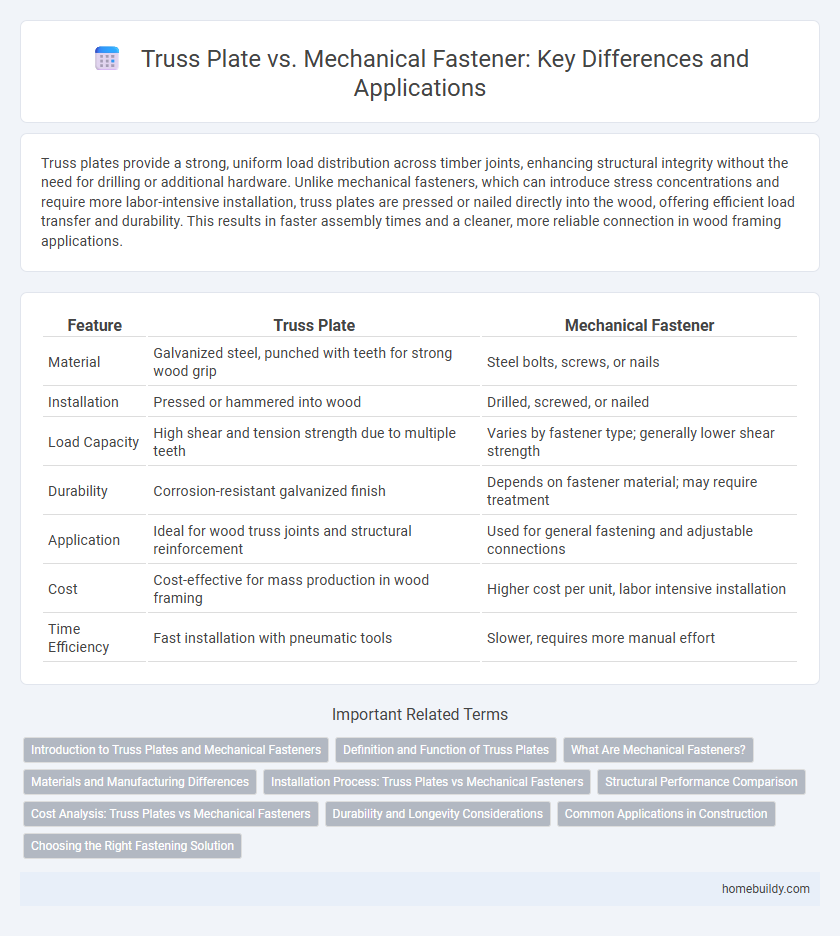Truss plates provide a strong, uniform load distribution across timber joints, enhancing structural integrity without the need for drilling or additional hardware. Unlike mechanical fasteners, which can introduce stress concentrations and require more labor-intensive installation, truss plates are pressed or nailed directly into the wood, offering efficient load transfer and durability. This results in faster assembly times and a cleaner, more reliable connection in wood framing applications.
Table of Comparison
| Feature | Truss Plate | Mechanical Fastener |
|---|---|---|
| Material | Galvanized steel, punched with teeth for strong wood grip | Steel bolts, screws, or nails |
| Installation | Pressed or hammered into wood | Drilled, screwed, or nailed |
| Load Capacity | High shear and tension strength due to multiple teeth | Varies by fastener type; generally lower shear strength |
| Durability | Corrosion-resistant galvanized finish | Depends on fastener material; may require treatment |
| Application | Ideal for wood truss joints and structural reinforcement | Used for general fastening and adjustable connections |
| Cost | Cost-effective for mass production in wood framing | Higher cost per unit, labor intensive installation |
| Time Efficiency | Fast installation with pneumatic tools | Slower, requires more manual effort |
Introduction to Truss Plates and Mechanical Fasteners
Truss plates are specialized steel connectors used to join wooden truss members, providing high strength and rigidity through embedded teeth that distribute loads effectively. Mechanical fasteners, such as bolts and screws, attach components by clamping surfaces together but may require additional reinforcement for structural stability. Unlike mechanical fasteners, truss plates offer a faster installation process and improved load transfer in engineered wood structures.
Definition and Function of Truss Plates
Truss plates are flat steel connectors with multiple teeth designed to embed into timber, creating a strong, rigid joint when pressed into wooden members. Mechanical fasteners, such as bolts or screws, rely on penetration and clamping forces to hold components together, whereas truss plates provide distributed load transfer through their embedded teeth, enhancing joint stability and load resistance. The primary function of truss plates is to efficiently join and reinforce wooden trusses by ensuring uniform stress distribution and preventing joint slippage under various load conditions.
What Are Mechanical Fasteners?
Mechanical fasteners are hardware devices, such as bolts, screws, nuts, and rivets, used to join two or more components securely by applying clamping force. Unlike truss plates, which are metal connectors designed to be embedded into wood for structural support, mechanical fasteners provide removable or adjustable connections in various materials. Their versatility allows for easy assembly and disassembly, making them essential in construction and manufacturing where flexibility and maintenance are critical.
Materials and Manufacturing Differences
Truss plates are typically made from galvanized steel sheets that are stamped or pressed to form multiple teeth for enhanced load distribution, whereas mechanical fasteners like bolts or screws consist of high-strength steel or alloy metals machined or forged to precise shapes. The manufacturing process of truss plates involves embossing and cutting to create uniform teeth that penetrate wooden surfaces for rigid connections, contrasting with mechanical fasteners that require threading or shaping to facilitate assembly. These material and manufacturing distinctions influence their performance characteristics, with truss plates providing consistent shear transfer across joints and mechanical fasteners offering adjustable tension and disassembly options.
Installation Process: Truss Plates vs Mechanical Fasteners
Truss plates offer a streamlined installation process by requiring simple pressing or nailing, reducing labor time compared to mechanical fasteners, which often need precise drilling, alignment, and tightening. The uniformity of truss plates ensures consistent load distribution and minimizes installation errors, whereas mechanical fasteners demand more skill for proper torque and placement to maintain structural integrity. Speed and simplicity in installing truss plates help improve efficiency, especially in large-scale truss assembly projects.
Structural Performance Comparison
Truss plates offer superior load distribution and enhanced joint stability compared to mechanical fasteners, resulting in improved overall structural integrity. Their design ensures consistent stress transfer across connections, minimizing the risk of localized deformation and failure. Mechanical fasteners may create stress concentrations that reduce performance under dynamic or heavy loads, while truss plates maintain rigidity and durability in critical structural applications.
Cost Analysis: Truss Plates vs Mechanical Fasteners
Truss plates offer a cost-effective solution compared to mechanical fasteners due to lower material expenses and reduced labor time during installation. Mechanical fasteners, such as bolts and screws, often incur higher costs from both purchase and prolonged assembly requiring skilled labor. Overall, truss plates deliver enhanced economic efficiency in large-scale wood framing projects by minimizing total expenditure.
Durability and Longevity Considerations
Truss plates, made from galvanized steel and designed for embedded connections, offer superior corrosion resistance and consistent load distribution compared to mechanical fasteners like bolts or nails, which can loosen over time. The durability of truss plates is enhanced by their resistance to environmental factors, ensuring long-term structural integrity without frequent maintenance. Mechanical fasteners may experience wear and fatigue under cyclic loads, leading to reduced longevity in comparison to the robust performance of properly installed truss plates.
Common Applications in Construction
Truss plates are predominantly used in wooden roof truss assemblies, providing efficient load transfer and uniform distribution of forces across joints. Mechanical fasteners, such as bolts and nails, are commonly applied in timber framing and steel connections where adjustability and disassembly are required. Both methods play crucial roles in structural integrity but are selected based on application-specific demands like load type, installation speed, and material compatibility.
Choosing the Right Fastening Solution
Truss plates provide a streamlined and cost-effective solution for connecting timber elements, offering higher load distribution and resistance to shear forces compared to mechanical fasteners. Mechanical fasteners like bolts and nails allow for adjustable and removable connections but may require additional tools and maintenance. Selecting the right fastening solution depends on factors such as structural requirements, ease of installation, load capacity, and long-term durability in specific applications.
Truss plate vs Mechanical fastener Infographic

 homebuildy.com
homebuildy.com